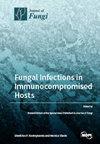Global Epidemiology of Invasive Infections by Uncommon Candida Species: A Systematic Review
IF 4.2
2区 生物学
Q2 MICROBIOLOGY
引用次数: 0
Abstract
Emerging and uncommon Candida species have been reported as an increasing cause of invasive Candida infections (ICI). We aim to systematize the global epidemiology associated with emergent uncommon Candida species responsible for invasive infections in adult patients. A systematic review (from 1 January 2001 to 28 February 2023) regarding epidemiological, clinical, and microbiological data associated to invasive Candida infections by uncommon Candida spp. were collected. In total, 1567 publications were identified, and 36 were selected according to inclusion criteria (45 cases). The chosen studies covered: C. auris (n = 21), C. haemulonii (n = 6), C. fermentati (n = 4), C. kefyr (n = 4), C. norvegensis (n = 3), C. nivariensis (n = 3), C. bracarensis (n = 1), C. duobushaemulonii (n = 1), C. blankii (n = 1), and C. khanbhai (n = 1). Over the recent years, there has been an increase in the number of invasive infections caused by uncommon Candida spp. Asia and Europe are the continents with the most reported cases. The challenges in strain identification and antifungal susceptibility interpretation were significant. The absence of clinical breakpoints for the susceptibility profile determination for uncommon Candida spp. makes interpretation and treatment options a clinical challenge. It is crucial that we focus on new and accessible microbiology techniques to make fast and accurate diagnostics and treatments.不常见念珠菌侵袭性感染的全球流行病学:系统回顾
据报道,新出现的不常见念珠菌菌种越来越多地成为侵袭性念珠菌感染(ICI)的病因。我们的目的是系统整理与导致成人患者侵袭性感染的新兴不常见念珠菌属相关的全球流行病学。我们收集了与非常见念珠菌属侵袭性念珠菌感染相关的流行病学、临床和微生物学数据,并对这些数据进行了系统回顾(从 2001 年 1 月 1 日至 2023 年 2 月 28 日)。共发现 1567 篇文献,根据纳入标准选出 36 篇(45 例)。所选研究包括C. auris (n = 21)、C. haemulonii (n = 6)、C. fermentati (n = 4)、C. kefyr (n = 4)、C. norvegensis (n = 3)、C. nivariensis (n = 3)、C. bracarensis (n = 1)、C. duobushaemulonii (n = 1)、C. blankii (n = 1) 和 C. khanbhai (n = 1)。近年来,由不常见的念珠菌属引起的侵袭性感染数量有所增加。菌株鉴定和抗真菌药敏性解释面临巨大挑战。在确定不常见念珠菌属的药敏谱时缺乏临床断点,这使得解释和治疗方案成为临床挑战。至关重要的是,我们应关注新的、可获得的微生物学技术,以进行快速、准确的诊断和治疗。
本文章由计算机程序翻译,如有差异,请以英文原文为准。
求助全文
约1分钟内获得全文
求助全文
来源期刊

Journal of Fungi
Medicine-Microbiology (medical)
CiteScore
6.70
自引率
14.90%
发文量
1151
审稿时长
11 weeks
期刊介绍:
Journal of Fungi (ISSN 2309-608X) is an international, peer-reviewed scientific open access journal that provides an advanced forum for studies related to pathogenic fungi, fungal biology, and all other aspects of fungal research. The journal publishes reviews, regular research papers, and communications in quarterly issues. Our aim is to encourage scientists to publish their experimental and theoretical results in as much detail as possible. Therefore, there is no restriction on paper length. Full experimental details must be provided so that the results can be reproduced.
 求助内容:
求助内容: 应助结果提醒方式:
应助结果提醒方式:


